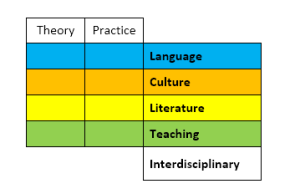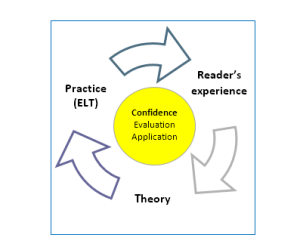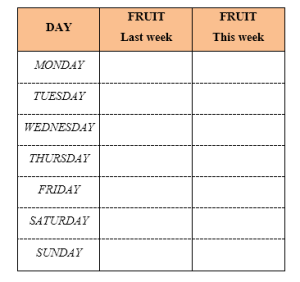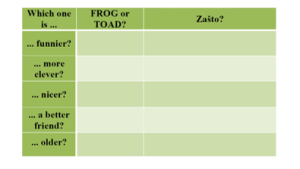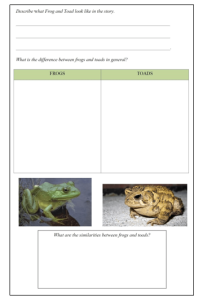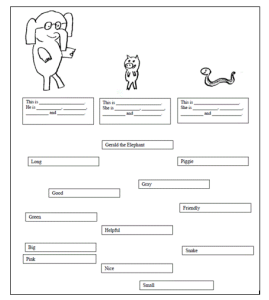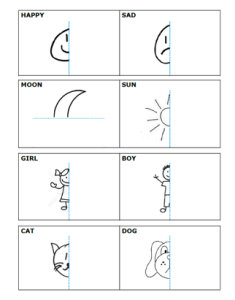| Picturebooks in Educating Teachers of English to Young Learners
Smiljana Narančić Kovač |
Download PDF |
Abstract
There are three major aspects of studying picturebooks which are relevant for future FL teachers: familiarity with a range of picturebooks, theoretical considerations, and practical issues, such as evaluating picturebooks, understanding their potential in FL learning and an ability to design activities for young learners. To exemplify ways of addressing picturebooks in pre-service teacher education, this article shows how these aspects are covered in the study programme of primary English at the Faculty of Teacher Education in Zagreb, Croatia. Beginning with a brief explanation of how this programme evolved from the seminal work of Mirjana Vilke, it also presents examples of picturebook-related activities for use with young learners, designed by pre-service students. The article concludes that an understanding of the theoretical and historical background to picturebooks empowers teachers to use them in their teaching practice in an efficient way.
Keywords: picturebooks, young learners, teacher education, English as a foreign language, student teachers, teaching materials
Smiljana Narančić Kovač, PhD, Assistant Professor, developed the study programme for primary English teachers at the University of Zagreb, Croatia. She serves as the principal investigator for BIBRICH (2015–2018), a national project about translations of children’s literature. Her publications include a monograph on picturebook as narrative (2015). [End of Page 6]
Some History, Some Context
We are fortunate that pioneers in early language learning shared their wisdom in designing EFL curricula based on multimodal or visual texts and literature. Books such as The Storytelling Handbook for Primary Teachers (Ellis & Brewster, 1991) and The Primary English Teacher’s Guide (Brewster, Ellis & Girard, 1991) provided reasonable and convincing foundations as well as useful examples of suitable books for the young learner classroom. These publications introduced picturebooks as delightful and functional resources, helping young learners to break the ice when using another language. In the 1990s, it was also possible to read individual teachers’ classroom experiences, claiming, for example, that learners associate ‘reading in the target language with positive experiences’ (Machura, 1995) and that ‘real reading needs real books’ (Parker & Parker, 1995). Good picturebooks were attractive, appropriate, and posed no difficulty to young learners. On the contrary: they were readily embraced by children. They were exactly what young language learners needed – if they were available.
It is worthwhile going back a little in time to the period before the 1990s, when awareness by European policy makers about the need of learning other languages was on the rise, and the foundations of an ordered international system of language education were being negotiated. These processes included some research projects concerning young learners, and, albeit sporadically, university courses offered to students of English. In the winter term of the academic year 1978/1979, there was an elective course in the module of teaching methodology at the English Language and Literature Department of the Faculty of Humanities and Social Sciences in Zagreb, titled ‘Foreign Language Acquisition at an Early Age’. This marked the beginning of a focus on young learners in English teacher education in Croatia, and it is closely connected with the later development of a study programme for teachers of primary English at another faculty of the same university, the programme that embraces picturebooks as an important issue in educating EFL teachers. In order to fully understand the principles and the treatment of picturebooks within this study programme at the Faculty of Teacher Education (FTE) in Zagreb, some historical background is needed to describe its genesis and reveal its foundations. [End of Page 7]
The above-mentioned course on early language learning was offered by Mirjana Vilke (1931-2012), based upon her 1973-1978 pilot project, which focused on investigating the possibilities of introducing FL learning to children under 10 years old (grade four), which was standard in Croatia at the time (Vilke, 2015a). The aim of the project was to provide evidence concerning the process of learning English in a formal school environment. The starting points were the findings of neurophysiology and developmental psycholinguistics, as well as evidence collected by previous research on L2 or FL acquisition. In its different stages, the project included cooperation with Croatian teachers of English and observing children in language schools and in regular state schools (Vilke, 2015a). Teaching materials were adapted from a few second-language courses and created by teachers themselves. Stories, games, songs and some action rhymes were also used. Picturebooks were rarely included; it was still very difficult to get books from abroad in the 1970s as Croatia was one of the six states in the former communist Yugoslavia. It is good to remember that it was the time when a personal computer was not an available commodity, let alone the internet. Even videocassette recorders were still a novelty. Picturebooks from the English-speaking cultures were still beyond reach, but not for long.
Another project commenced in 1991.1 It was, however, in Vilke’s own words, ‘a venture the start of which coincided with the start of the war into which Croatia was forced in order to preserve her independence and freedom’ (2015b, p. 13). Notwithstanding the war, Croatia was opening towards the world. Picturebooks were largely used in 1990s research projects, as well as other original materials. Meg and Mog (Nicoll & Pieńkowski, 1972) and its sequels were true favourites, as well as Jan Pieńkowski’s pop-up books such as Dinner Time (Carter & Pieńkowski, 1981), Little Monsters (Pieńkowski, 1983) and Small Talk (Pieńkowski, 1985). Vida Nikpalj employed traditional fairy tales and picturebooks in her drama activities, such as Duckling Swims, a board book by Rosalinda Kightley (1985), to encourage children to produce their own stories (Nikpalj, 1993/2015, p. 87). Lidvina Štokić (1993/2015) introduced Mr. Bear’s Book of Rhymes (Dunn & Wong, 1979) and Mirjana Tomašević-Dančević (1995/2015) stories, non-fiction materials, and picturebooks by Eric Carle, such as The Very Hungry Caterpillar (1969) and The Tiny Seed (1970). It soon became clear that picturebooks, [End of Page 8] as well as children’s literature in general, were desirable and advantageous in teaching English in primary education (Narančić Kovač, 1999; Narančić Kovač & Likar, 2001/2015).
Vilke soon realized that a special study programme for primary English teachers would be needed to provide ‘teachers properly suited for the job’, i.e. the primary teachers ‘trained to teach the foreign language from the first to the fourth grade’ (Vilke, 2015a, p. 27). A reform of teacher education coincided with her initiative, and in 1993 three lecturers were employed at FTE (Teacher Education Academy at the time) with this aim in mind. Within a few years they developed a comprehensive study programme of primary English in combination with the primary education programme. Now, over twenty years later, it is taught by a team of more than a dozen educators, and picturebooks play a very big part in the programme. Thus it was early 1990s that brought new winds in teaching English to young learners, and those winds also brought picturebooks. They have become indispensable both in English language education classes and in teacher education.
Reasons for Including Picturebooks in Teacher Education
Teachers who are expert in early foreign language education generally agree that picturebooks are invaluable resources. They offer an authentic experience for language use and prompt children to express themselves activating what language knowledge they have acquired. They are mandatory for student teachers specialising in young learners. Janice Bland points out that ‘picturebooks can introduce a playful process involving imagination and experimentation in the EFL classroom’ (2013, p. 93). Also, picturebooks offer material that can maintain young learners’ interest for longer periods of time because they return to picturebooks over and over again. Thus picturebooks help develop interest in stories and reading in general.
Other reasons comprise the opportunities good picturebooks offer for developing visual and verbal literacy, i.e. constructing meanings based on verbal and visual clues, encountering information about other cultures and target language contexts and practices, acquiring higher-order skills in understanding complex narrative meanings, developing critical thinking and sense of humour, achieving participatory and interactive reading. All these goals were achieved in a case study on sharing the picturebook Cockatoos (Blake, 1994) with first graders [End of Page 9] (Hanžić & Narančić Kovač, 2008). The potential of picturebooks for language learning ‘arises from the active engagement that takes place between learner and book, which results in participation with and use of language’ (Mourão, 2015, p. 214). Even very young learners are capable of understanding narrative meanings conveyed through, for example, peritextual features of picturebooks, e.g. the front and back covers, the endpapers, title pages, and copyright and dedication pages as discussed in Mourão (2013). Picturebooks are used as an incentive for creative responses, for sharing experiences and thoughts, for bouncing off viewpoints, and for spending class time in an enjoyable way. Future teachers should be able to recognize the potential of picturebooks in language learning and to be able to apply their knowledge in practice. But how can it be achieved?
Three aspects come to the foreground as fields of interest in educating primary English teachers: familiarity with a corpus of picturebooks, picturebook theory and application in practice. Ideally, what we aim at is ‘an appropriate balance between theory, practice and reflection’ (Ellis & Read, 2015, p. 129).
Student teachers would need to be familiar with a short history of picturebooks and explore a considerable number of picturebook classics and recently published titles, taking a reader’s and a learner’s perspective. As they become familiar with many picturebooks, they can also examine them from the perspective of their possible use in teaching. Theoretical considerations refer to such issues as understanding the semiotic models and the intermediality of the picturebook, the relationship of its discourses in meaning-making, its narrative communication, and typical features. Practical issues involve developing evaluation criteria for choosing quality picturebooks, realizing the opportunities picturebooks offer in teaching practice, and an ability to autonomously develop appropriate teaching materials based on individual picturebooks and design activities tailored to young learners’ needs.
These three aspects contribute to three main outcomes: understanding what a picturebook is, developing criteria of evaluation and learning how to efficiently incorporate picturebooks into their teaching. There are different ways to do this and the approach presented here is the approach to picturebooks in the study programme for primary teachers of English at FTE. [End of Page 10]
Studying to Become a Primary Teacher of English
In Zagreb, English teachers are educated at two institutions: The Faculty of Humanities and Social Sciences, and FTE, where studying English is combined with primary education in a five-year integrated course of study, leading to a master in education. Regarding workload, expressed through European Credit Transfer and Accumulation System (ECTS),2 about one third of total ECTS credits is earned in the EFL segment, while the larger portion of the programme, covering about two-thirds of the total ECTS credits, develops primary teachers’ competences. This involves preparation to teach all the other subjects of the primary curriculum. The topic of picturebooks is addressed in courses focusing on Croatian language and literature in the general section, and in several courses in the EFL section.
Depending on individual choices of elective courses, the EFL segment comprises approximately 100 ECTS credits in five years, and an exposure to about ten contact classes in English per week on average (15 weeks per term). Also, student teachers attend 41 compulsory courses in the EFL segment; four per term. Course contents are related to four main areas of study: language, culture, literature, and teaching. Interdisciplinary approaches are common and theoretical and practical aspects are covered in all these areas (Figure 1).
Figure 1. Areas of interest in educating FL teachers. [End of Page 11]
Different Perspectives on Picturebooks
Every year, there is at least one course in which student teachers encounter picturebooks. Some courses are practical, others theoretical (and historical) (Figure 2). The courses Creative Teaching Activities 1 and 2 (in the first and the second years, respectively) expose students to picturebooks from a receiver’s perspective. They encounter picturebooks along with other materials (e.g. songs, rhymes and stories) from the English-speaking world. Students participate in activities based on original materials and experience both teaching and learning roles. Picturebook authors they may come across at this stage include Eric Carle, Simms Taback, Quentin Blake, Dr. Seuss, Julia Donaldson & Alex Scheffler, David Shannon, David Campbell, and Eric Hill.
Key: Y = year, L = language, C = culture, Lt = literature, T = teaching
Figure 2: The study programme at Zagreb University
In the third year, in the course on Children’s Literature in English, students are acquainted with the history of children’s book illustration and of the picturebook. The course offers the following:
- A comprehensive history of children’s literature and related literary systems (from nursery rhymes and folk tales to popular fiction) microsoft project alternative free.
- An overview of genres (from limericks and ABC books to narrative fiction).
- Various concepts and notions related to the field, such as literacy, nonsense, subversiveness, censorship, adaptation, intertextuality, metafiction. [End of Page 12]
- An introduction to children’s literature research including basic theoretical approaches and research problems (such as reader-response theory, psychoanalytical criticism and narratology).
Regarding picturebooks, a short overview comprises major illustrators and picturebook classics such as Little Black Sambo by Helen Bannerman (1898), The Tale of Peter Rabbit by Beatrix Potter (1902), to represent British production at the turn of the 20th century, and Millions of Cats by Wanda Gág (1928) as an example of the development of American picturebooks. The flourishing of their picturebooks in the 1940s and 1950s is represented by such titles as The Little House by Virginia Lee Burton (1940), Goodnight Moon by Margaret Wise Brown and Clement Hurd (1947) and The Snowy Day by Ezra Jack Keats (1952). The variety of picturebook production in the second half of the 20th century is exemplified by highly acclaimed titles from the English-speaking world, including Where the Wild Things Are by Maurice Sendak (1963), Rosie’s Walk by Pat Hutchins (1969), Each Peach Pear Plum by Janet and Allan Ahlberg (1978) and Sunshine by Jan Ormerod (1982).
Once students acquire a historical perspective, they are ready to explore specific aspects of the picturebook as a form. In the fourth year in the course titled Picturebooks, they consider the picturebook from a theoretical perspective and investigate the word-picture relationship, the intermediality of the picturebook, its theoretical models and typical ways of meaning-making, including the role of its peritextual features. The process of reading and re-reading is discussed, as well as the flexibility of picturebook as a form, its dialogism, its tendency to include intertextuality and metafiction and its variations in terms of genres and expressive devices. Usually the focus is on such authors as Maurice Sendak, Anthony Browne, the Ahlbergs, Anno, David Wiesner, David Macaulay, Lauren Child, Emily Gravett, Jan Scieszka & Lane Smith, Peter Sís, Shaun Tan, Raymond Briggs. Picturebooks used at this stage are complex, sophisticated and often postmodern, so that students can experience what a picturebook can offer. Each student works on one picturebook throughout the course, and analyses it from a different viewpoint every week. They reflect on various aspects of [End of Page 13] picturebook form and its meanings. For instance, one week they research the author, another week they describe the format and design of the picturebook they study. They compare the picturebook with other narrative or non-narrative genres and explore its intermediality. They focus on visual narration and consider word-picture relationship, reading trajectories and interactivity. They look for intertext and metafictive devices in verbal and visual discourses and study the picturebook as a postmodern piece. Students also read a scholarly paper related to their picturebook. Finally, they report on their findings in class and produce a short essay. A passage from an essay on Fungus the Bogeyman (Briggs, 1977) by Filip Džankić exemplifies outcomes of such an exploration and presents how this student understands the reading process and the borderline status of this title:
There is one special thing I did not think of on my own, but Suzanne Rahn (1983-1984) directed my attention towards it: the pace.
Comic books are usually, more or less, fast paced works of literature where you absorb the pictures along with the text and although slower to read than regular books, [they are] still quite fast; it is not so with Fungus. Here the very scientific nature of the narrative, an in depth look into Bogeymen slows the pace down.
You read the narrative, then you look up an explanation, then you read another in depth explanation and then you look back at something that is more clear because of that, and then you go to the internet to look something up to compare the book to the real world; this slows you down to a nice, Bogey, calm, laid back pace, just as they like it.
Thus, students gradually develop criteria for evaluating picturebooks and for choosing those that can be useful for EFL learners.
In the final stage, during the fifth year, in the course Literature in Teaching English, students apply the knowledge and experience they have collected by taking picturebooks into the classroom. They combine the teacher competences they have developed throughout their course of study in both general and EFL courses and are expected to autonomously develop teaching materials and design activities based on individual picturebooks and tailor these to [End of Page 14] their learners’ needs. In this way a cyclic process is initiated for each student teacher, and there is hope that it would continue throughout their teaching career (see Figure 3).
Figure 3. A cyclical process of developing confidence throughout a teaching career.
Widening the reading experience, i.e. encountering additional picturebooks, provides student teachers (and later, teachers) with a wide range of books from which they can choose. Gradually, the possibility to compare new specimens with an ever-larger number of picturebooks they have read helps student teachers to rely on their own judgment with more confidence. Next, their acquaintance with the theoretical issues – their understanding of ‘how picturebooks work’ (Sipe, 1998; Nikolajeva & Scott, 2001), empowers them to competently analyse the picturebook they are considering and understand how it fits the specific features of the form and if and how it challenges or explores conventions; and also to reflect on, question and modify previously acquired theoretical models. This in turn helps the student teachers to use the picturebook in class in an efficient and productive way, confident of their own expertise.
The class event is the final test. It is followed by reflection on the success of sharing the picturebook with pupils, problems encountered in class, children’s reactions and efficiency [End of Page 15] in achieving educational goals; all that in connection with the student teacher’s understanding of the teaching and learning processes based on educational theories and their own competences. If needed, the activities and the treatment of the picturebook are modified for the next event, or another selection is made. This stage (the practice) thus expands the teaching experience and again adds to the self-confidence of an individual that the potentials of a picturebook will be recognized when a new picturebook is encountered. Thus the process continues building up the confidence of an individual practitioner.
The reason that one of the crucial concepts in the model is confidence in the teacher’s own expertise, lies in the fact that it makes it possible for teachers to make an additional step towards non-prescribed materials and take an active role in their learning process. Especially for a Croatian EFL teacher, it is connected with an incentive to put a special effort into finding appropriate picturebooks. Croatian bookshops do not offer a wide range of quality English picturebooks, so the mere fact that student teachers know there are such picturebooks motivates them to find others and enrich their teaching by using them. Expanding this knowledge with insights into picturebook theory and into examples of good practice of using picturebooks in English language classes only adds to this impetus and makes it even more meaningful, and needed. On the other hand, the lack of confidence in many newly trained teachers leads to adopting pre-set teaching practices, sticking to ready-made teaching materials and abandoning creativeness, novelty and excitement of the learning process that would lead to success – they resort to such excuses as lack of class time and the unconsciously self-imposed need to stick to prescribed teaching plans or even strictly to the textbook only. They stop being subjects of the teaching process and betray their vocation. By contrast, self-confident teachers are likely to use picturebooks in teaching through developing confidence – and that can only be done through knowledge based on experience, research based on theory, and reflective practice. It leads to inventiveness, developed criteria of selection and evaluation, and, finally, to the application of creative and effective teaching techniques. [End of Page 16]
Activities for Young Language Learners
This section includes examples of activities developed by individual students during the course Literature in Teaching English. They were expected to create five activities based around the same narrative, which is age and level appropriate. The activities should cover language and narrative aspects, address various competences, and include individual and group work. Students were expected to ensure the activities are fun, neither too easy nor too difficult.
The selected examples demonstrate various aspects of the process explained above. The picturebooks were selected from various resources: picturebook classics widely used in ELT (Example 1), and other titles encountered while studying (Example 2), or new titles by familiar authors (Example 3 and Example 4). Different criteria of selection are applied: in Example 1 the picturebook was selected because it was appropriate for an EFL vocabulary task, and in Example 4 because the student knew some picturebooks by the same authors that were inspiring for EFL, and because he recognized the potential of this particular picturebook for interesting and efficient teaching activities. This demonstrates the range of possibilities of selection based on the wide reading experience and knowledge of a considerable number of picturebooks.
Some theoretical issues are also detected: multimodality (Examples 2, 3 and 4), fictionality (Example 2), narrative aspects (Example 2 and Example 3), exploration of both visual and verbal texts (Example 4). Teaching methodology and practice come to the fore, for instance, in activities that ensure participation by all pupils in class (Example 4), involve a personal perspective (Example 1), develop critical thinking skills (Example 2), and demonstrate effective classroom management (Example 4). Individual activities are commented on below.
Example 1: Fruit Eaters (suggested target age: 7 – 8/9 and up)
The Very Hungry Caterpillar (Carle, 1969) – Student: Ivana Žigić
The activity based on this picturebook, widely used in ELT, is very simple, but functional. It adds a personal perspective to the reading experience, combined with vocabulary revision. [End of Page 17] Children are asked to draw fruit they ate last week in appropriate cells in Table 1, and then they need to draw fruit as they eat it every day. Pupils develop a visual-verbal connection which helps them remember new words. In the process, health issues are also addressed.
Table 1. A grid for drawing pieces of fruit.
Example 2: Compare Frog(s) and Toad(s) (suggested target age: age 9/10 – 10/11 and up)
‘The Hat’ (Lobel, 1979) – Student: Ivana Švaljek
Table 2. Comparing Frog and Toad. [End of Page 18]
Here children compare and evaluate the characters and provide an explanation for their opinion in Croatian (‘Zašto?’ means ‘Why?’) (Table 2). Thus they develop critical thinking skills. The description of characters and their looks reveals the ways of characterisation, as an aspect of a narrative, in both visual and verbal discourses and raises their awareness of the multimodality of picturebooks.
In the next step they dig deeper to explore the world of nature and study the differences and similarities of real-life frogs and toads (Table 3). By considering the differences between real animals and fictional characters they encounter the notion of fictionality.
Table 3. Comparing frogs and toads [End of Page 19]
Example 3: Meet the Characters (suggested target age: age 8/9 – 9/10 and up)
Can I play Too? (Willems, 2010) – Student: Petra Jurković
Pupils use some nouns and adjectives to describe the characters and thus understand them better (Figure 4). Again, characterisation is detected in both discourses, emphasizing its multimodal nature in picturebooks. While pupils practise writing and vocabulary, the focus is on a literary interpretation.
Figure 4. Characters [End of Page 20]
Example 4: Words and Cats (suggested target age: age 6/7 – 8/9 and up)
Tabby McTat (Donaldson & Scheffler, 2009) – Student: Emanuel Golenko
Step one: What’s in a name? Before the pupils see the book, they discuss some photographs of cats using English whenever they can. Then they discuss the cover illustration. The teacher helps them: ‘Tabby McTat got the name Tabby because of the way he looks. What does he look like?’ Children soon discover the stripy, tiger-like pattern. They explore the photographs again to find more tabby cats.
Step two: While reading the book together, learners stop to look for cats and other animals on every double-page spread.
Step three: Rhyming or not? Pupils copy the rhyming words, and draw pictures of things denoted by the remaining words (Figure 5).
Figure 5. Rhyming words, writing and drawing
Step four. Pairs and opposites. There are two versions of this game with half-finished drawings (Figure 6). In the first version children are divided into pairs, and each pupil gets a set of four cards, either ‘happy’, ‘moon’, ‘girl’ and ‘cat’, or ‘sad’, ‘sun’, ‘boy’, and ‘dog’. They need to finish the pictures and then, working in pairs, find the opposites and match them.
In the other version, each child gets a card, and when the picture is finished he or she walks around the classroom to find someone who has a matching card. Alternatively, pupils may form eight groups, one for each card. What happens in each of these steps can be described as follows: [End of Page 21]
Step one: Pupils focus on the visual discourse and connect it with the protagonist’s name – they consider the multimodality of the picturebook in this way.
Step two: Pupils examine the visual discourse.
Step three: Pupils examine the verbal discourse: they experience that two discourses convey the story in parallel. This demonstrates that the student teacher understands the semiotic structure of the picturebook well, and that s/he employs it while sharing the picturebook with the class.
Step four: Children are actively engaged drawing and then finding pupils with matching cards. The task involves a lot of movement around the classroom, but the goals are clearly set. Therefore, the teacher is in command and pupils have enough freedom to be creative and successful, which demonstrates efficient classroom management.
Figure 6. Pairs and opposites [End of Page 22]
Example 4 shows that this student has competences connected with the three steps of the confidence-building process (Figure 3): the selection of the picturebook is based on the reader’s experience, that is the knowledge of a wide range of picturebooks, and the activities reveal the understanding of the theory of picturebooks and of the teaching and learning processes, based on teaching practice.
All these examples show that the aspects of teacher education related to picturebooks as described here – the knowledge of a wide range of picturebooks, exploring the theory and connecting it with active and creative teaching practice – enabled student teachers to use picturebooks with young learners in an appropriate way and to autonomously develop meaningful and efficient activities for them. Perhaps not all the students are equally creative and independent, but it is certain that they are prepared and willing to share picturebooks with their pupils and discover new ways of doing it.
Final Remarks
It is difficult to imagine primary English language teacher education without addressing picturebooks, and it is useful if three major issues are included in it: familiarity with a number of picturebooks, theoretical considerations, and practical issues. Probably the most important component in teachers’ professional development is the practice. However, they are more successful if they understand the background. Combining all three aspects of studying picturebooks described here is bound to help primary English teachers achieve a satisfactory level of competence and confidence needed to use picturebooks efficiently and creatively with young learners.
Notes
1 It was the project Investigating learning and acquisition of foreign languages at an early school age, launched in 1991, followed by a similar project of the same team, led by Yvonne Vrhovac (1997-2002). It was one of a network of similar projects from member states of the Council of Europe, titled Language Learning for European Citizenship in the period (1989-1997), which ‘witnessed the rapid enlargement of and the enrichment of the programme by the participation of the newer member states from Central and Eastern Europe’ (Council of Europe, 2014). One of those ‘newer member states’ was Croatia, which participated in the programme with Vilke’s project of 1991-1996. On a larger scale, these were the activities that led to the establishment of the [End of Page 23] European Centre for Modern Languages in 1994, and such documents as Common European Framework of Reference for Languages and European Language Portfolio at the beginning of the 21st century.
2 ECTS is standard for higher education across the European Union. An ECTS credit stands for the amount of students’ workload of 27-30 hours. A year of study corresponds to 60 ECTS credits.
Bibliography
Blake, Q. (1994). Cockatoos. London: Red Fox.
Briggs, R. (1977). Fungus the Bogeyman. London: Hamish Hamilton Ltd.
Carle, E. (1969). The Very Hungry Caterpillar. Cleveland and New York: World Publishing Company.
Carle, E. (1970). The Tiny Seed. New York: Aladdin.
Carter, A. (1981). Dinner Time. J. Pieńkowski (Illus.). London: Gallery Five.
Donaldson, J. (2009). Tabby McTat. A. Scheffler (Illus.). London: Alison Green Books.
Dunn, O. (1979). Mr. Bear’s Book of Rhymes. D. Wong (Illus.). London: Macmillan Publishers Ltd.
Kightley, R. (1985). Duckling Swims. London.
Lobel, A. (1979). The Hat. In Days With Frog And Toad. New York: Harper & Row.
Nicoll, H. (1972). Meg and Mog. J. Pieńkowski (Illus.). London: Puffin.
Pieńkowski, J. (1983). Little Monsters. London: Gallery Five.
Pieńkowski, J. (1985). Small Talk. London: Orchard.
Willems, M. (2010). Can I Play, Too? New York: Hyperion Books for Children.
References
Bland, J. (2013). Fairy Tales with a Difference. In J. Bland & C. Lütge (Eds.), Children’s Literature in Second Language Education. London: Bloomsbury, pp. 85-94.
Brewster, J., Ellis, G. & Girard, D. (1991). The Primary English Teacher’s Guide. London: Penguin.
Council of Europe. (2014). Language Policy Division: A Brief History. Retrieved May 7, 2016, from Education and Languages, Language Policy: http://www.coe.int/t/dg4/linguistic/historique_en.asp [End of Page 24]
Ellis, G. & Brewster, J. (1991). The Storytelling Handbook for Primary Teachers . London: Penguin.
Ellis, G. & Read, C. (2015). Course design and evaluation in primary teacher education. In C. Nicole Giannikas, L. McLaughlin, G. Fanning & N. Deutsch Muller (Eds.), Children Learning English: From Research to Practice. Reading: Garnet Publishing, pp. 115-135.
Hanžić, S. & Narančić Kovač, S. (2008). Čitanje slika i nastanak priče – studija slučaja. In A. Bežen & D. Pavličević-Franić (Eds.), Prvi specijalizirani znanstveni skup Rano učenje hrvatskoga jezika (RUHJ). Zagreb: ECNSI, Učiteljski fakultet, pp. 66-80.
Machura, L. (1995). Using literature in language teaching. In C. Brumfit, J. Moon & R. K. Tongue (Eds.), Teaching English to Children: From Practice to Principle. 2nd ed. London: Longman, pp. 67-80.
Mourão, S. (2013). Picturebook: Object of discovery. In J. Bland & C. Lütge (Eds.), Children’s Literature in Second Language Education. London: Bloomsbury, pp. 71-84.
Mourão, S. (2015). The potential of picturebooks with young learners. In J. Bland (Ed.), Teaching English to Young Learners: Critical Issues in Language Teaching with 3-12 Year Olds. London: Bloomsbury, pp. 199-217.
Narančić Kovač, S. (1999). Dječja književnost u nastavi stranoga jezika. In Y. Vrhovac et al (Eds.), Strani jezik u osnovnoj školi. Zagreb: Naprijed, pp. 257-271.
Narančić Kovač, S. & Likar, D. (2001/2015). Reading authentic stories in English as a foreign language with seventh graders. In J. Mihaljević Djigunović (Ed.), Children and English as a Foreign Language Zagreb: FF press, pp. 156-172.
Nikolajeva, M. & Scott, C. 2001. How Picturebooks Work. New York & London: Garland.
Nikpalj, V. (1993/2015). Elements of drama in teaching English to young learners. In J. Mihaljević Djigunović (Ed.), Children and English as a Foreign Language Zagreb: FF press, pp. 83-95.
Parker, R. & Parker, R. (1995). Real reading needs real books. In C. Brumfit, J. Moon & R. Tongue (Eds.), Teaching English to Children: From Practice to Principle. 2nd ed. London: Longman, pp. 178-190. [End of Page 25]
Rahn, S. (1983-1984). Beneath the surface with Fungus the Bogeyman. The Lion and the Unicorn, 7/8, 5-19.
Sipe, L.R. (1998). How Picture Books Work: A semiotically framed theory of text-picture relationsips. Children’s Literature in Education, 29(2), 97-108.
Štokić, L. (1993/2015). Music and verses in teaching English to young learners. In J. Mihaljević Djigunović (Ed.), Children and English as a Foreign Language. Zagreb: FF press, pp. 78-82.
Tomašević-Dančević, M. (1995/2015). Environmental education and creativity in teaching English. In J. Mihaljević Djigunović (Ed.), Children and English as a Foreign Language. Zagreb: FF press, pp. 108-118.
Vilke, M. (2015a). Early foreign language teaching in Croatian primary schools. In J. Mihaljević Djigunović (Ed.), Children and English as a Foreign Language. Zagreb: FF press, pp. 17-30.
Vilke, M. (2015b). Introduction. In J. Mihaljević Djigunović (Ed.), Children and English as a Foreign Language. Zagreb: FF press, pp. 13-16. [End of Page 26]


